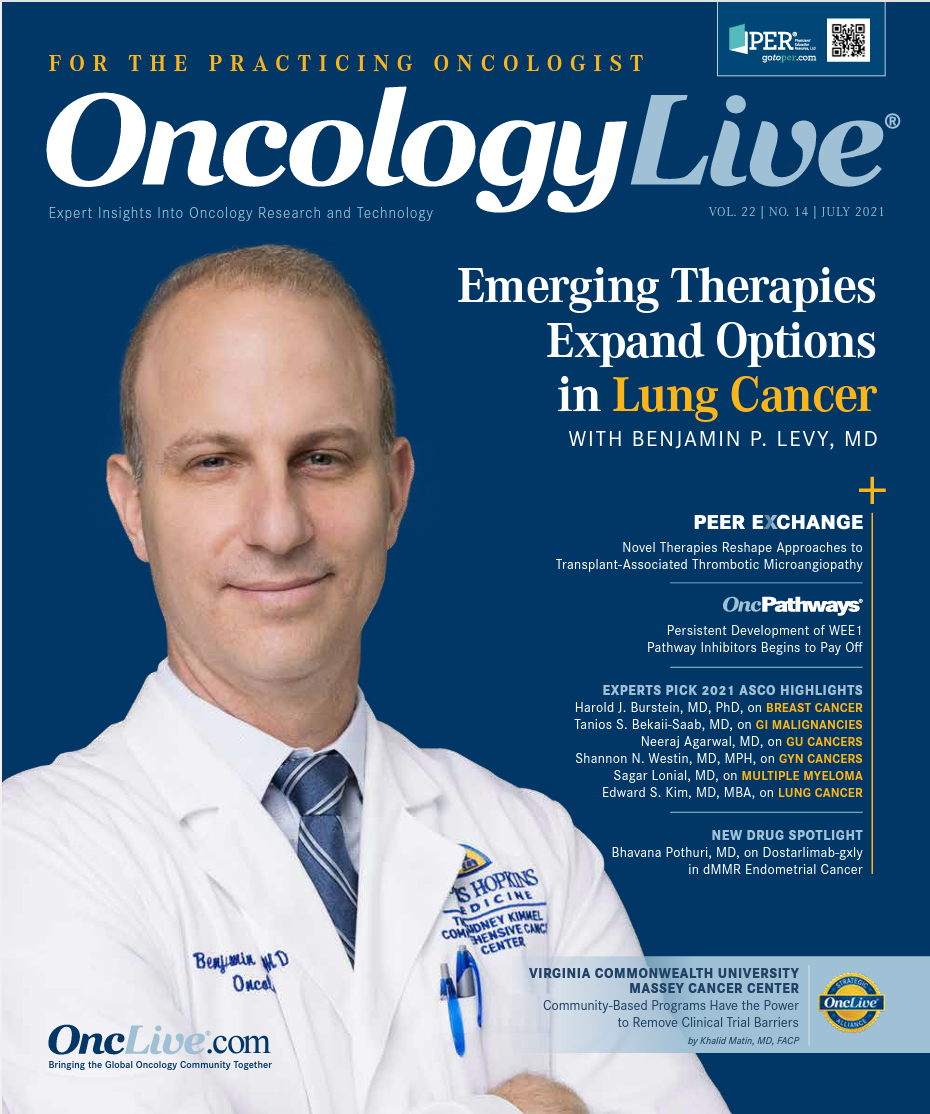Publication
Article
Oncology Live®
Amivantamab Paves a New Treatment Path for Patients With EGFR Exon 20–Mutant NSCLC
Author(s):
Amivantamab ushers in a new era of targeted treatment for patients with locally advanced or metastatic non–small cell lung cancer with EGFR exon 20 insertion mutations.
Melina Elpi Marmarelis, MD,

Amivantamab ushers in a new era of targeted treatment for patients with locally advanced or metastatic non–small cell lung cancer with EGFR exon 20 insertion mutations. This population accounts for approximately 4% to 10% of patients with NSCLC whose disease harbors an EGFR mutation and who are often resistant to treatment with available EGFR tyrosine kinase inhibitors (TKIs).1
On May 21, 2021, the FDA granted accelerated approval for the bispecific antibody directed against MET receptors and EGFR, specifically for those patients who have progressed on or following platinum- based chemotherapy. The FDA simultaneously approved the liquid biopsy assay Guardant360 CDx as a companion diagnostic for amivantamab.2
The decision was based on data from the phase 1 CHRYSALIS (NCT02609776) trial, a multicenter, nonrandomized, open-label, multicohort clinical study evaluating amivantamab as monotherapy for patients whose disease presented with EGFR exon 20 insertion mutations.
Results showed an overall response rate of 40% (95% CI, 29%-51%) among 81 patients enrolled in the cohort that received prior platinum-based chemotherapy. The agent elicited a complete response rate of 3.7% and a partial response rate of 36%. The median duration of response was 11.1 months (95% CI, 6.9–not estimable) and 63% of responders had a response lasting at least 6 months.3
Though the data are immature, the agent has also demonstrated early efficacy in median overall and progression-free survival data, which were reported as 22.8 months (95% CI, 17.5–not available) and 8.3 months (95% CI, 6.5–10.9), respectively.4 Further, when compared with real-world data from patients treated with available therapies in the post platinum-based chemotherapy setting, treatment with amivantamab delayed time to next therapy by 10 months (14.8 months vs 4.8 months, respectively [HR, 0.4; 95% CI, 0.28-0.57]).
In an interview with OncologyLive®, Melina Elpi Marmarelis, MD, an assistant professor of medicine at the Hospital of the University of Pennsylvania, Perelman School of Medicine, University of Pennsylvania, in Philadelphia, discussed how the approval shifts the treatment paradigm for this subgroup of patients and how the agent may fill other unmet clinical needs.
What was noteworthy about the efficacy data that led to this approval?
The overall response rate was quite impressive for a second-line drug. It was approximately 40% and the median duration of response was 11.1 months. The overall survival data are still not mature, but those are both encouraging, especially in the second-line setting.
Please explain amivantamab’s mechanism of action.
Amivantamab is a bispecific antibody; it has 2 heads to the antibody: One is against EGFR, and the other is against MET. It targets resistance mechanisms in EGFR alteration–positive NSCLC and also, in particular, EGFR exon 20 alterations in [patients with] NSCLC.
What adverse effects do clinicians need to be aware of when prescribing this drug
The most common [adverse effect that was] seen was infusion reaction, which is fairly universal [among] patients. [Reactions] to the initial infusion [resulted in amivantamab] needing to be stopped, delayed, slowed down, and sometimes even resumed the next day. That happened with only the first dose, and then subsequently patients were tolerant. [Amivantamab] also has some class effects, such as rash, diarrhea, and other things that we would see with other EGFR-targeted therapies, but those were minimal. The most prominent was an initial infusion reaction.
How does this approval shift the treatment paradigm of EGFR-mutant NSCLC?
Prior to this, there was no targeted therapy approved for patients with NSCLC [with] an EGFR exon 20 alteration. Recently at [the 2021 American Society for Clinical Oncology Annual Meeting, investigators] presented [results of] a real-world study out of France that showed that patients with EGFR exon 20–altered NSCLC treated with conventional chemotherapies did just [as well as] as individuals without EGFR alterations, showing that there’s a gap in targeting this type of EGFR alteration.4 [Amivantamab will] hopefully start to fill that gap.
What does the future hold for amivantamab?
[Amivantamab] is poised [to stay in] the second-line setting after initial platinum chemotherapy. It will hopefully move to the first-line setting and be combined with an EGFR-targeted TKI that has CNS [central nervous system] penetration. One of the potential problems with this type of a drug is that it doesn’t cross the blood-brain barrier and therefore does not help the disease that’s in the [CNS]. In combination with an EGFR-targeted TKI, [amivantamab] could be highly effective in the first-line setting.
Generally EGFR exon 20 alterations represent approximately 10% of all EGFR mutations, but this is likely underreporting [the population] given that many [institutions] are still [conducting] targeted EGFR sequencing and are not looking for an exon 20 alteration. I hope that this approval encourages broad-based, next-generation sequencing to find these mutations now that we have targeted therapy for [patients who harbor] them.
References
- Pacini L, Jenks AD, Vyse S, Wilding CP, Arthur A, Huang PH. Tackling drug resistance in EGFR exon 20 insertion mutant lung cancer. Pharmgenomics Pers Med. 2021;14:301-317. doi:10.2147/PGPM.S242045
- FDA grants accelerated approval to amivantamab-vmjw for metastatic non–small cell lung cancer. FDA. Updated May 21, 2021. Accessed June 29, 2021. bit.ly/3yu0Ycz
- Rybrevant. Prescribing information. Janssen Biotech Inc; 2021. Accessed June 21, 2021. bit.ly/3ACvNgR 4.
- Minchom AR, Girard N, Bazhenova L, et al. Amivantamab compared with real-world therapies in patients with NSCLC with EGFR Exon 20 insertion mutations who have progressed after platinum doublet chemotherapy. J Clin Oncol. 2021;39(suppl 15):9052. doi:10.1200/JCO.2021.39.15_suppl.9052









